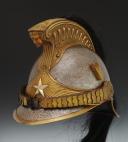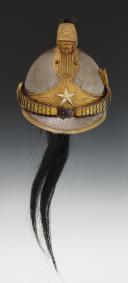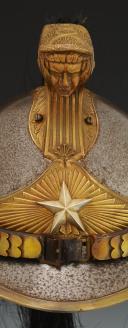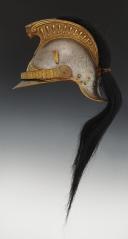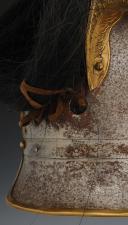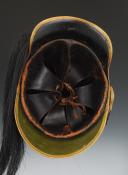
Hussar Troop Helmet, model 1910 described in 1913, Third Republic. 30165
Sold out
Hussar Troop Helmet, model 1910 described in 1913, Third Republic. 30165
One-piece bombshell made of mirrored polished steel sheet. It is pierced at the top with five suction cup holes, the interior of the bombshell is later painted black. Stamped on the back with size "55" and the manufacturer "SIRAUDIN PARIS" and "A".
Steel visor bordered by a 0.8 cm wide brass strip placed along the outer edge. The underside of the visor is painted green.
The neck guard is identical to the visor with its interior painted black.
Brass headband stamped with a radiant sun on a sandblasted background, H 6.5 cm. In the center, a five-pointed star, diameter 4 cm, is attached.
Each chin strap consists of 13 copper scales, alternately cut into three or two festoons, decreasing in width from 2.4 cm for the top scale to 1.7 cm for the bottom scale. The right chin strap is decorated at its end with a small copper plate riveted to which a buckle, also in copper, is attached. At the end of the left chin strap, there is a similar plate holding a copper "D" with a partly missing black varnished leather chin chain. The top scale of each chin strap is covered with a circular copper rosette, diameter 3.9 cm, with three raised strips.
Brass crest composed of two fins, a mask, and a cover.
The fins are stamped with palmettes and a border at their top edge; the lower part forms a scalloped rim adorned with water leaves, attached to the bombshell with two screws, all stamped in relief. Height of the fins 6.5 cm.
A tin plate joins the upper edges of the fins, fixing their spacing.
The mask is stamped with a relief head of Medusa. The cover, also stamped, represents the continuation of Medusa's hair with intertwined snakes (length 9 cm).
Black horsehair mane, length 50 cm.
Brass plume holder, tubular in shape with a square section, slightly tapering towards the bottom, H 3.5 cm.
Interior lining of black waxed leather cut into eight teeth.
France.
Third Republic.
Good condition, never cleaned, oxidation on steel parts.
NOTE REGARDING THE HELMETS OF HUSSARS AND LIGHT CAVALRY HUSSARS, model 1910:
After numerous attempts at headgear, this model was chosen as the standard model. Its entry into service was slow and interrupted by the Great War. It was adopted in 1910 but it was not until September 22, 1913, that its description was published in the official military bulletin.
On April 27, 1910, "La France Militaire" reported that the lightened dragon helmet "is being tested in a regiment of light cavalry - the 17th or 18th of Lunéville - and in the 6th a regiment of hussars of Commency".
In April 1911, the 5th regiment of light cavalry from Châlons took part in the autumn maneuvers wearing the 1910 model helmet.
However, after its introduction, this helmet remained stored in the clothing stores as part of the war collection. While eight light cavalry regiments received it after the start of hostilities in 1914, only the 5th regiment was equipped with it at mobilization. The final report of the 1911 trials noted that the helmet was considered the ideal headgear for light cavalry. Budget allocations of 66,444 francs in 1913, and 140,000 francs in 1914 were made for its distribution in seventeen light cavalry regiments, but it took a year of war for twelve regiments to finally receive it starting in June 1915 (perhaps thirteen regiments with the 3rd Hussars, although there is no written proof, there are photos from that time).
This helmet never became the standard for light cavalry officers before the war, as evidenced by the absence of its description in the April 1914 edition of volume 104 of the BOEM which maintained the shako as the prescribed headgear. After the outbreak of hostilities, the helmets issued to officers were of the troop type, as per the ministerial decision of November 24, 1914.
On April 22, 1914, the Minister of War announced having 3,800 light cavalry helmets and 1,880 hussar helmets: "these inventories allow for issuing helmets to five light cavalry regiments, to four squadrons or three regiments with six squadrons, and two hussar regiments with four squadrons, and to create with the surplus, in the depots of the concerned units, a reserve of helmets for the equipment of reinforcements." The text adds, "the 1st, 5th, 13th (noted in pencil), 15th, and 20th light cavalry regiments are already equipped with the helmet. The introduction of helmets will make a significant quantity of shakos available, as stated by the minister to General Joffre."
The distribution of helmets continued during the summer in strict compliance with the April instructions: 2nd and 4th Hussars on June 10, 14th Light Cavalry on June 23, 10th Light Cavalry on July 15 (received on July 10, 1915), 13th Light Cavalry on July 16, 17th and 18th Light Cavalry on July 31. The 8th Hussar Regiment was the only one of its armament subdivision to have received the 1910 model helmet before August 1914. The 15th Light Cavalry Regiment received the helmet on March 11, 1915.
The 1st Hussar Regiment was equipped with the helmet as a replacement for shakos according to a decision on October 3, 1915, as reported in the military official journal. However, it is most likely referring to the Adrian helmet.
One-piece bombshell made of mirrored polished steel sheet. It is pierced at the top with five suction cup holes, the interior of the bombshell is later painted black. Stamped on the back with size "55" and the manufacturer "SIRAUDIN PARIS" and "A".
Steel visor bordered by a 0.8 cm wide brass strip placed along the outer edge. The underside of the visor is painted green.
The neck guard is identical to the visor with its interior painted black.
Brass headband stamped with a radiant sun on a sandblasted background, H 6.5 cm. In the center, a five-pointed star, diameter 4 cm, is attached.
Each chin strap consists of 13 copper scales, alternately cut into three or two festoons, decreasing in width from 2.4 cm for the top scale to 1.7 cm for the bottom scale. The right chin strap is decorated at its end with a small copper plate riveted to which a buckle, also in copper, is attached. At the end of the left chin strap, there is a similar plate holding a copper "D" with a partly missing black varnished leather chin chain. The top scale of each chin strap is covered with a circular copper rosette, diameter 3.9 cm, with three raised strips.
Brass crest composed of two fins, a mask, and a cover.
The fins are stamped with palmettes and a border at their top edge; the lower part forms a scalloped rim adorned with water leaves, attached to the bombshell with two screws, all stamped in relief. Height of the fins 6.5 cm.
A tin plate joins the upper edges of the fins, fixing their spacing.
The mask is stamped with a relief head of Medusa. The cover, also stamped, represents the continuation of Medusa's hair with intertwined snakes (length 9 cm).
Black horsehair mane, length 50 cm.
Brass plume holder, tubular in shape with a square section, slightly tapering towards the bottom, H 3.5 cm.
Interior lining of black waxed leather cut into eight teeth.
France.
Third Republic.
Good condition, never cleaned, oxidation on steel parts.
NOTE REGARDING THE HELMETS OF HUSSARS AND LIGHT CAVALRY HUSSARS, model 1910:
After numerous attempts at headgear, this model was chosen as the standard model. Its entry into service was slow and interrupted by the Great War. It was adopted in 1910 but it was not until September 22, 1913, that its description was published in the official military bulletin.
On April 27, 1910, "La France Militaire" reported that the lightened dragon helmet "is being tested in a regiment of light cavalry - the 17th or 18th of Lunéville - and in the 6th a regiment of hussars of Commency".
In April 1911, the 5th regiment of light cavalry from Châlons took part in the autumn maneuvers wearing the 1910 model helmet.
However, after its introduction, this helmet remained stored in the clothing stores as part of the war collection. While eight light cavalry regiments received it after the start of hostilities in 1914, only the 5th regiment was equipped with it at mobilization. The final report of the 1911 trials noted that the helmet was considered the ideal headgear for light cavalry. Budget allocations of 66,444 francs in 1913, and 140,000 francs in 1914 were made for its distribution in seventeen light cavalry regiments, but it took a year of war for twelve regiments to finally receive it starting in June 1915 (perhaps thirteen regiments with the 3rd Hussars, although there is no written proof, there are photos from that time).
This helmet never became the standard for light cavalry officers before the war, as evidenced by the absence of its description in the April 1914 edition of volume 104 of the BOEM which maintained the shako as the prescribed headgear. After the outbreak of hostilities, the helmets issued to officers were of the troop type, as per the ministerial decision of November 24, 1914.
On April 22, 1914, the Minister of War announced having 3,800 light cavalry helmets and 1,880 hussar helmets: "these inventories allow for issuing helmets to five light cavalry regiments, to four squadrons or three regiments with six squadrons, and two hussar regiments with four squadrons, and to create with the surplus, in the depots of the concerned units, a reserve of helmets for the equipment of reinforcements." The text adds, "the 1st, 5th, 13th (noted in pencil), 15th, and 20th light cavalry regiments are already equipped with the helmet. The introduction of helmets will make a significant quantity of shakos available, as stated by the minister to General Joffre."
The distribution of helmets continued during the summer in strict compliance with the April instructions: 2nd and 4th Hussars on June 10, 14th Light Cavalry on June 23, 10th Light Cavalry on July 15 (received on July 10, 1915), 13th Light Cavalry on July 16, 17th and 18th Light Cavalry on July 31. The 8th Hussar Regiment was the only one of its armament subdivision to have received the 1910 model helmet before August 1914. The 15th Light Cavalry Regiment received the helmet on March 11, 1915.
The 1st Hussar Regiment was equipped with the helmet as a replacement for shakos according to a decision on October 3, 1915, as reported in the military official journal. However, it is most likely referring to the Adrian helmet.
Reference :
30165
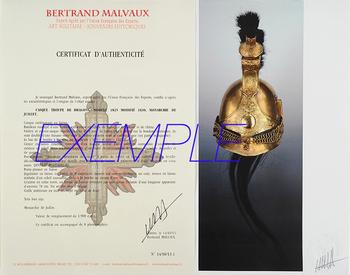
Next update Friday, april 4th at 1:30 PM
FOR ALL PURCHASES, PAYMENT IN MULTIPLE CHECKS POSSIBLE
bertrand.malvaux@wanadoo.fr 06 07 75 74 63
An authenticity certificate of the item including the description published on the site, the period, the sale price, accompanied by one or more color photographs is automatically provided for any item priced over 130 euros. Below this price, each certificate is charged 5 euros.
Only items sold by me are subject to an authenticity certificate, I do not provide any expert reports for items sold by third parties (colleagues or collectors).
